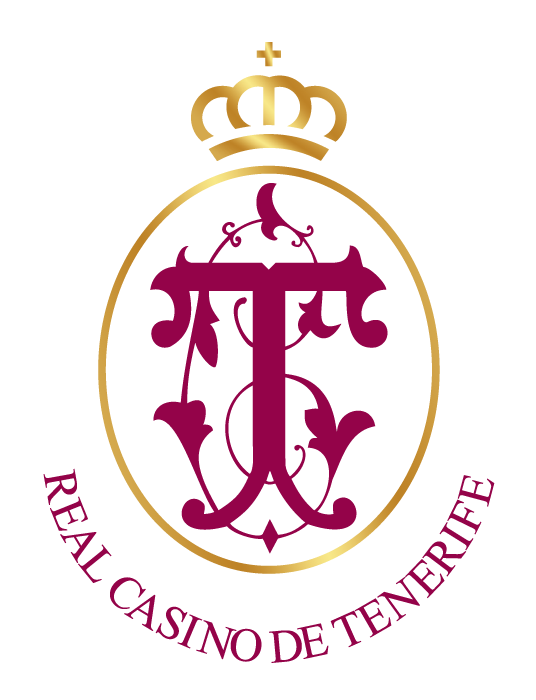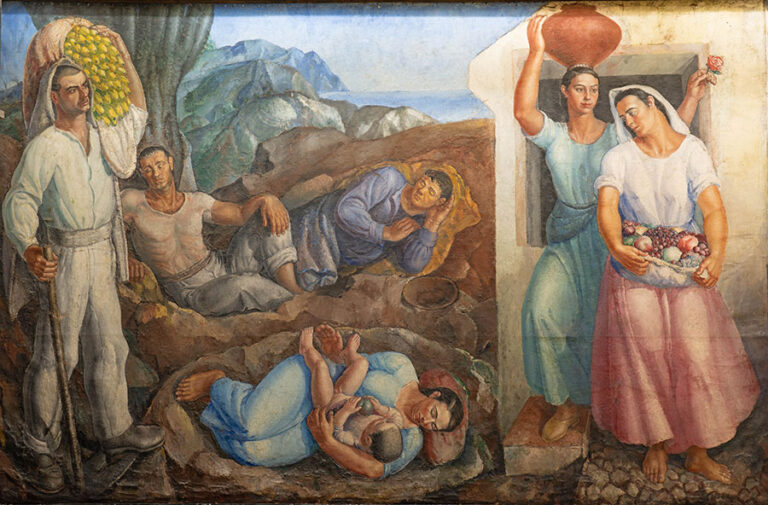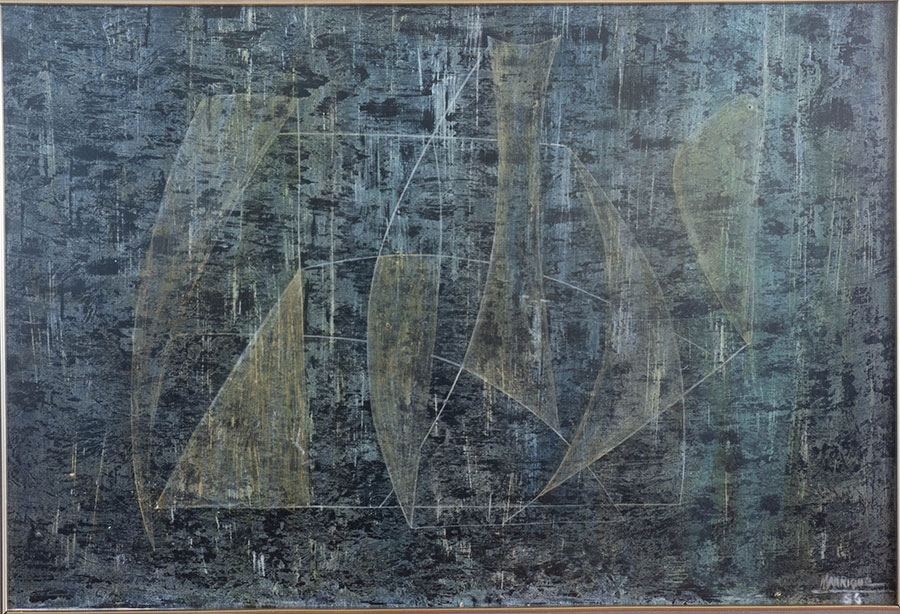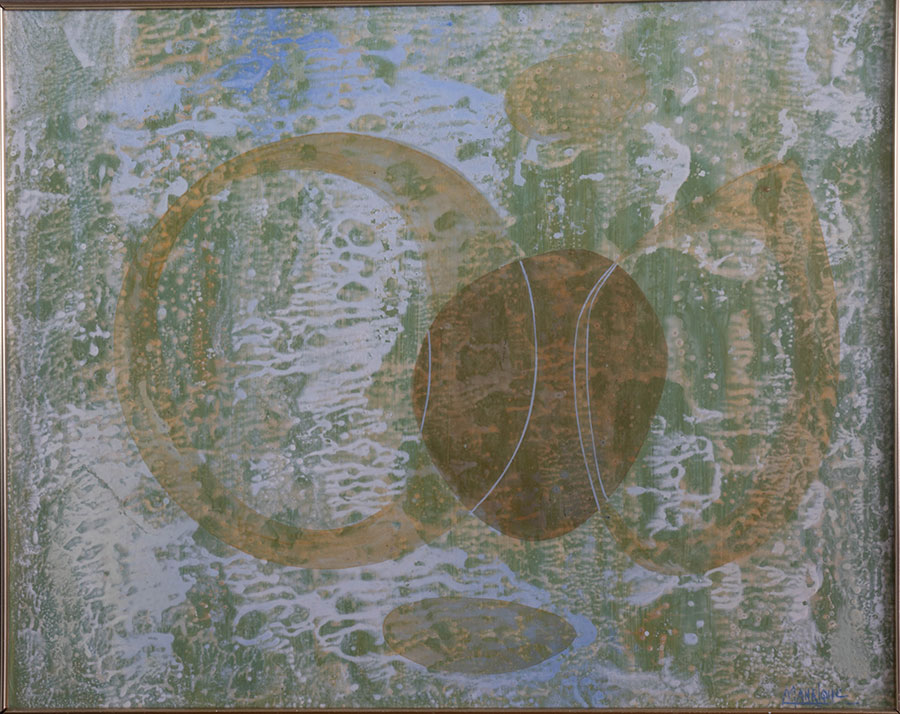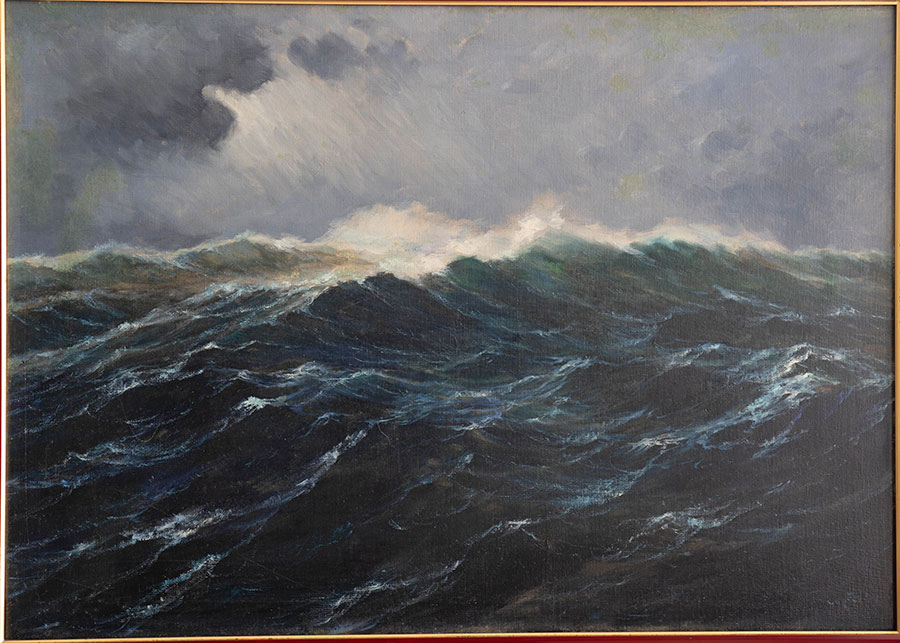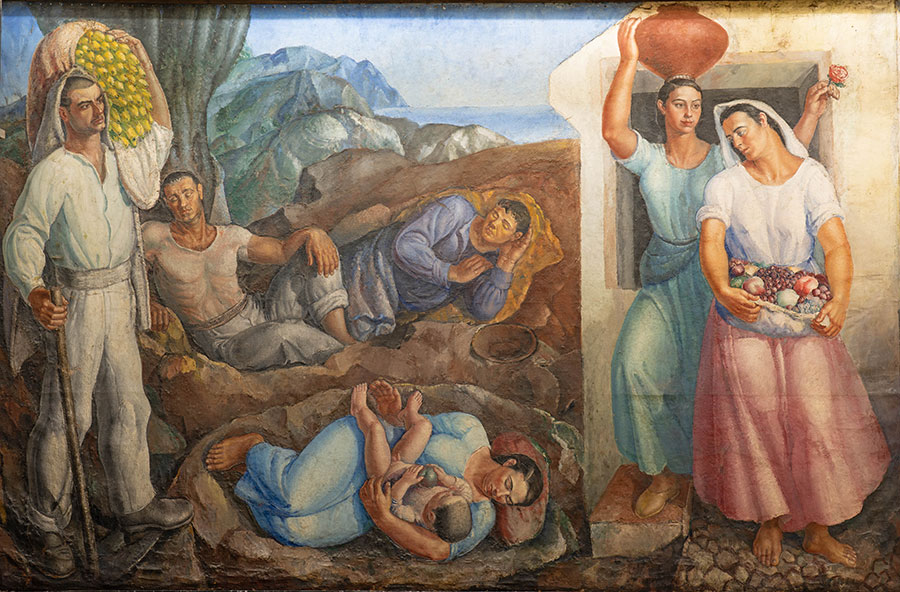
- Type of work: Mural painting
- Technique: Encaustic on canvas
- Approximate dimensions: 320 x 1136 cm
- Subject: Allegorical-indigenist
- Title: Friso Isleño
- Author: José de Aguiar (1895-1976)
- Chronology or Year: (1933-1941)
- Historical-artistic analysis:
Style: Painting of regionalist character but in search of the expression of a Canarian identity (racial painting).
Description: It is a monumental composition, not so much for its dimensions but for the gigantism and monumentality of the figures in it. Set in an open stage with the sea in the background, the sea paradoxically becomes a narrow horizon due to the presence of the solid and powerful figures that build the space that surrounds and constrains them. Two scenes are represented, one agricultural and the other marine, symbols of the two pillars of the island’s economy at the time. On the right is the seafaring allegory: the sea as a means of work and subsistence in the farewell of the fisherman who departs in his boat. The two female nudes of robust women, lying on the rocks, isolated from the context, have been interpreted as a hedonistic vision of the sea. On the left he paints the peasant people, but not in the exaltation of their work, but in the moment of rest, of the siesta under the shade or exhibiting the fruits of their effort. They are muscular figures of humble workers, sturdy peasants with large feet and hands, powerful in their simplicity and dignity, but with a self-absorbed and melancholic expression. A silent solitude and stillness immobilizes the scene. This self-absorption is accentuated in the gaze of the dreamy adolescent, with his sailboat, the link between the two scenes. The work reveals a formal classicism, both for the compositional arrangement and for the solidity and plasticity of the figures sculpted with a vibrant and luminous palette of acid and intense colors, undoubtedly the result of his contact with the art of Masaccio or Michelangelo during his stay in Italy in 1930.
Date of receipt: 1941
Remarks: The work was commissioned by the Casino for the decoration of the lobby of its new building by means of a contract signed with the painter on December 9, 1933, in which the dimensions, the form of fragmentation, the payment stipulated at 19,000 pesetas and the deadline for execution were fixed. Although the work should have been finished in five months (May 1934), the delay on the part of the artist in its execution, its exhibition in Madrid and Paris in 1936 after due authorization by the Casino and the loss of the canvases – which should have been transferred to Tenerife from Alicante – due to the outbreak of the Civil War, led to their arrival at their destination in August 1941, when the artist himself placed them on the wall of the lobby, for which he had been transferred expressly from Madrid. The work was finally assembled on September 18, 1941, and a special party was organized for the occasion for the members of the organization.
Restorations: Although four years after its inauguration the first alarm was raised, probably due to problems caused by the installation, it was in 1978 when it was restored by Waldo Aguiar, the author’s son and also a painter by profession, due to the wrinkles and bagging of the canvas caused by deficiencies in the installation and lighting.
About the author: José Aguiar García (Vueltas de Santa Clara, Cuba,1895- Madrid, 1976), born in Cuba into a family of emigrants, soon returned to La Gomera where he was baptized in the parish of San Marcos de Agulo. He went to Madrid in 1914 to study Law, but abandoned his studies to study Fine Arts at the School of Fine Arts of San Fernando as a disciple of José Pinazo Martínez (1879 – 1938), continuing his training in Florence with a scholarship from the Cabildo Insular de La Gomera. In contact with Renaissance art (especially Masaccio and Michelangelo), he discovers the beauty of the nude and the encaustic technique that he will use for the first time in the Friso Isleño del Casino de Tenerife and will use from then on in his large murals. Since 1920, he has been participating in the National Exhibitions, obtaining a third medal in 1926 for Figures of the gold medal in 1929 for the Women of the Souththe medal of honor for Estío in 1944 and the gold medal of the Círculo de Bellas Artes of Madrid in 1934 with Nude seated. In 1959 he was named member of the Hispanic Society of America and in 1960 of the Academia de Bellas Artes de San Fernando.
Bibliography:
Archive of the Casino of Tenerife: Contract-writing between Faustino Martín Albertos and José Aguiar for the execution of the Friso Isleño.
Carmen Nieves CRESPO DE LAS CASAS: José Aguiar, his life and work. Aula de Cultura del Cabildo Insular de Tenerife. Santa Cruz de Tenerife, 1975.
Ángeles ABAD: José Aguiar. Viceconsejería de Cultura y Deportes del Gobierno de Canarias, Santa Cruz de Tenerife, 1991.
Valeriano WEYLER: The small history of a great casino (The one in Santa Cruz de Tenerife). Santa Cruz de Tenerife, 1964.
Agustín GUIMERÁ RAVINA, Alberto DARIAS PRÍNCIPE: El Casino de Tenerife 1840 – 1990, Santa Cruz de Tenerife, 1992.

